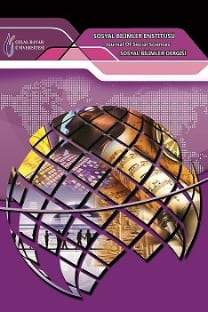Çalışanların Duygusal Sermayelerinin Demografik Değişkenler Açısından İncelenmesi
Duygusal Yeterlilikler, Duygusal Sermaye, Duygusal Beceriler, Demografik Değişkenler, Eğitim
Examining The Emotional Capital Of Employees In Terms Of Demographic Variables
___
- ANDREW, Yarrow, (2015), ‘I’m strong within myself’: gender, class and emotional capital in childcare, British Journal of Sociology of Education, 36(5), 651-668.
- BARUT, Yasin, (2015), Duygusal zekâ ve iletişim becerileri ilişkisi: örgüt kültürünün aracı rolü (İzmir Bozyaka Eğitim ve Araştırma Hastanesi ve Kent Hastanesinde görevli sağlık çalışanları örneği). Yayımlanmamış doktora tezi. Yaşar Üniversitesi, İzmir.
- BOURDIEU, Pierre, (1990), The logic of practice. Cambridge: Polity.
- CAHILL, Spencer, E., (1999), Emotional capital and professional socialization: the case of mortuary science students. Social Psychology Quarterly, 101-116.
- COLEMAN, James, S., (1994), Foundations of social theory. Cambridge: Belknap Press.
- COLLEY, Helen, (2003), Children can wind you up!: learning to labour in the nursery.In Gender and Education Association Conference 2003: Revisiting Feminist Perspectives on Gender and Education, 14-16 April 2003, Sheffield, UK. (Yayımlanmamış).
- COLLEY, Helen, (2006), Learning to labour with feeling: class, gender and emotion in childcare education and training. Contemporary Issues in Early Childhood, 7(1), 15-29.
- COŞKUN, Recai, ALTUNIŞIK, Remzi, BAYRAKTAROĞLU, Serkan ve YILDIRIM, Engin, 2015. Sosyal bilimlerde araştırma yöntemleri: SPSS uygulamalı. Sakarya: Sakarya Kitabevi.
- COTTINGHAM, Marci, D., (2013), Men who care: How organizations and individuals negotiatemasculinity, emotional capital, and emotion practice in nursing. Unpublished doctoral dissertation. The Graduate Faculty of the University of Akron.
- COTTINGHAM, Marci, D., (2016), Theorizing emotional capital. Theory and Society, 45(5), 451-470.
- DİREKÇİ, Emre, (2015), Duygusal Sermaye. Unpublished Working Paper, Aralık, https://www.researchgate.net/publication/301302089_Duygusal_sermaye
- FROYUM, Carissa, M., (2010), The reproduction of inequalities through emotional capital: the case of socializing lowincome black girls. Qualitative Sociology, (33), 37-54.
- GENDRON, Bénédicte, (2004), Why emotional capital matters in education and in labour? Towards an optimal exploitation of human capital and knowledge management, in Les cahiers de la maison des sciences economiques, No: 113, Paris: Universite Pantheon-Sorbonne.
- GENDRON, Bénédicte, (2007), Emotional capital and older workers learning and transfer of knowledge management: “toward a better ageing, working and learning together”. Human Resource Development Research & Practice across Europe, UFHRD, Oxford, July 2007.
- GILLIES, Val (2006). Working class mothers and school life: exploring the role of emotional capital. Gender and Education, 18(3), 281-293.
- GOLEMAN, Daniel, (2010), Duygusal zekâ neden IQ’dan daha önemlidir? B. Seçkin-Yüksel (Çev.). İstanbul: Varlık Yayınları.
- GÜLER, Ayşe, (2006), İlköğretim okullarında görev yapan öğretmenlerin duygusal zekâ düzeyleri ile problem çözme becerileri arasındaki ilişkinin incelenmesi. Yayımlanmamış yüksek lisans tezi. Yeditepe Üniversitesi, İstanbul.
- HILGER, Susanne, (2010), Utilizing the concept of “emotional capital” – “family” as an image and a narrative in 20th-century corporate communications. Paper for the EBHA Conference 2010 in Glasgow, 26th-28th August 2010.
- HOCHSCHILD, Arlie, Russell, (1983), The managed heart: commercialization of human feeling. Berkeley: University of California Press.
- JACKSON, E.N., (1959), Grief and religion. In The meaning of death, H. Feifel (Eds.), pp. 218-233. New York: McGraw-Hill.
- KIZIL, Şule, (2014), Öğretmenlerin duygusal zekâları ile örgütsel adanmışlıkları arasındaki ilişki (Balıkesir ili örneği). Yayımlanmamış yüksek lisans tezi. Okan Üniversitesi, İstanbul.
- NEWMAN, Martin ve Judy PURSE, (2007), Emotional capital report - technical manual. Melbourne: RocheMartin Institute
- NEWMAN, Martin (2008), Emotional capital inventory, ECI & ECI 360. Technical Paper, Roche Martin Institute, http://96.30.1.124/~rochema/blog/wp-content/uploads/ECi-Technical-Paper-V5.pdf
- NEWMAN, Martin, Judy PURSE, Ken SMITH ve John BRODERICK (2015), Assessing emotional intelligence in leaders and organisations: reliability and validity of the emotional capital report (ECR). Australasian Journal of Organisational Psychology, 8(6), 1-15.
- NEWMAN, Martin (2009), Emotional capitalists: the new leaders. Melbourne: John Wiley and Sons.
- NOWOTNY, Helga, (1981), Austria: Women in public life. In Access to power: cross-national studies of women and elites, C.F. Epstein ve R.L. Coser (Eds.), pp. 147-156. London: George Allen & Unwin.
- REAY, Diane, (2000), A useful extension of Bourdieu’s conceptal framework: Emotional capital as a way of understanding mothers’ involvement in their children’s education. The Sociological Review, 568-585.
- SEKARAN, Uma, (1992), Research methods for business. Canada: John Wiley &Sons, Inc.
- TAHERI, Haleh M. ve Saeed REZAYI, S. (2016), Study of emotional capital (feelings of happiness and empowerment) and its role on the development of organizational goals Pars Jame Jam civil Company. Scinzer Journal of Humanities, 2(3), 16-19.
- TURAN, Mehmet, (2015), Öğretmenlerin duygusal zekâ ve tükenmişlik düzeyleri arasındaki ilişkinin incelenmesi. Yayımlanmamış yüksek lisans tezi. İstanbul Gelişim Üniversitesi, İstanbul.
- XU, Zhenning ve Fernando, R. JIMÉNEZ, (2016), Emotional capital: the missing link between social media usage and customer relationship performance. In Let’s get engaged! crossing the threshold of marketing’s engagement era, pp. 859-860. Springer International Publishing.
- ZEMBYLAS, Michalinos, (2007), Emotional capital and education: theoretical insights from Bourdieu. British Journal of Educational Studies, 55(4), 443-463.
- ISSN: 1304-4796
- Yayın Aralığı: Yılda 4 Sayı
- Başlangıç: 2003
- Yayıncı: Manisa Celal Bayar Üniversitesi
NATO ve EURO Bölgesindeki Savunma Sanayilerinin İktisadi Etkinliği ve Toplam Faktör Verimliliği
Döviz Cinsi Krediler Bir “Döviz Riski” Azaltma Araci Mıdır? 2003-2018 Türkiye Analizi
Türkiye – Avrupa Birliği Geri Kabul Anlaşmasının Uygulanmasında Suriyelilerin Etkisi ve Rolü
Didem ŞAHAL ÇELİK, Sühal ŞEMŞİT
Falih Rıfkı Atay’ın Ulus Gazetesindeki Yazıları (1935-1937)
Hadımların Pers Saray Yaşamındaki Yeri
Mali Bakış Açısı ile Çevresel Kirliliklerin Azaltılmasında Elektrikli Taşıtların Rolü
Mehmet Emin KENANOĞLU, Timur TÜRGAY
Alternatif Varlık Fiyatlandırma Modelleri ve Borsa İstanbul'da Uygulama
Kar Amacı Olmayan İşletmelerde Entegre Raporlama ve Bir Örnek Olay
Finansal Okuryazarlık Düzeyi ile Sosyal Ağların Etkileşimi Üzerine Ampirik Bir Uygulama
